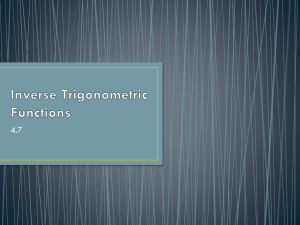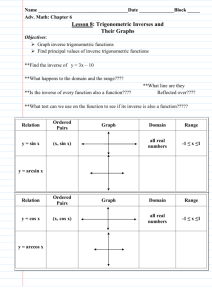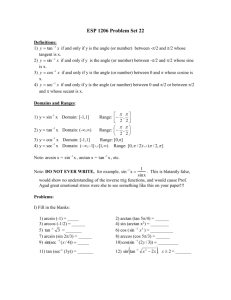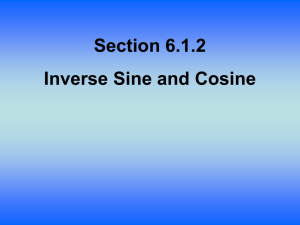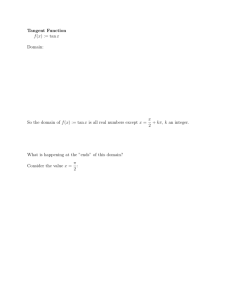6.8 * Trig Inverses and their graphs
advertisement
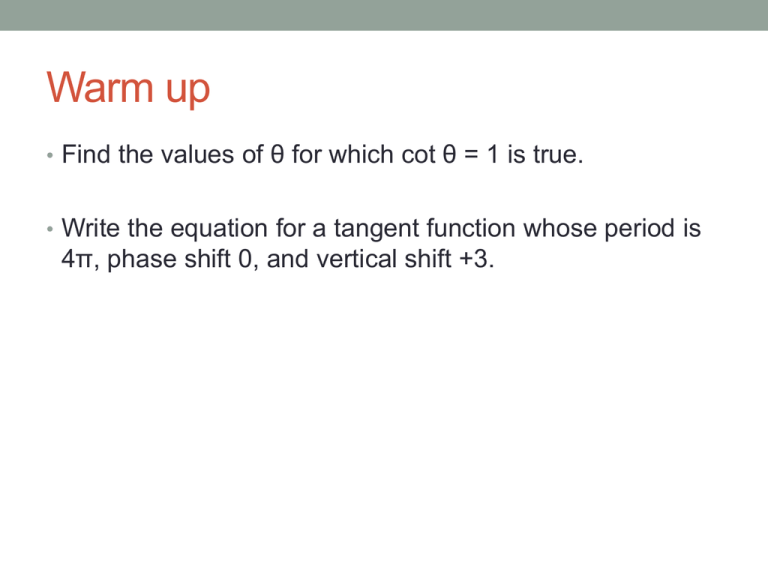
Warm up • Find the values of θ for which cot θ = 1 is true. • Write the equation for a tangent function whose period is 4π, phase shift 0, and vertical shift +3. LESSON 6-8 – TRIG INVERSES AND THEIR GRAPHS Objective: To graph inverse trigonometric functions. To find principal values of inverse trig functions. Quick Review • How do you find inverses of functions? We find inverses by interchanging the x and y values. • Are inverses of functions always functions? No • How did we test for this? Vertical line test. Inverse Trig Functions Original Function Inverse y = sin x y = sin-1 x y = arcsin x y = cos x y = cos-1 x y = arccos x y = tan x y = tan-1 x y = arctan x Consider the graph of y = sin x What is the domain and range of sin x? Domain: all real numbers Range: [-1, 1] What would the graph of y = arcsin x look like? What is the domain and range of arcsin x? Domain: [-1, 1] Range: all real numbers Is the inverse of sin x a function? • This will also be true for cosine and tangent. • Therefore all of the domains are restricted in order for the inverses to be functions. How do you know if the domain is restricted for the original functions? • Capital letters are used to distinguish when the function’s domain is restricted. Original Functions with Restricted Domain Inverse Function y = Sin x y = Sin-1 x y = Arcsin x y = Cos x y = Cos-1 x y = Arccos x y = Tan x y = Tan-1 x y = Arctan x Original Domains Restricted Domains Domain y = sin x Range y = Sin x y = sin x y = Sin x y = cos x all real numbers y = Cos x y = cos x y = Cos x y = tan x all real numbers except n, y = Tan x y = tan x y = Tan x all real numbers all real numbers all real numbers where n is an odd integer Complete the following table on your own Function Domain Range y = Sin x y = Arcsin x 1 x 1 2 y 2 y = Cos x y = Arccos x 1 x 1 y = Tan x y = Arctan x 0 y all real numbers all real numbers 2 y 2 Table of Values of Sin x and Arcsin x y = Sin x X y = Arcsin x Y X Y -π/2 -π/2 -π/6 -π/6 0 0 π/6 π/6 π/2 π/2 Why are we using these values? Principal Values – values of Sine, Cosine etc. when the domain is restricted. Graphs of Sin x and Arcsin x Table of Values of Cos x and Arccos x y = Cos x X y = Arccos x Y X Y 0 0 π/3 π/3 π/2 π/2 2π/3 2π/3 π π Why are we using these values? Graphs of Cos x and Arccos x Table of Values of Tan x and Arctan x y = Tan x X y = Arctan x Y X Y -π/2 -π/2 -π/4 -π/4 0 0 π/4 π/4 π/2 π/2 Why are we using these values? Graphs of Tan x and Arctan x Write an equation for the inverse of y = Arctan ½x. Then graph the function and its inverse. To write the equation: 1. Exchange x and y 2. Solve for y Let’s graph 2Tan x = y first. Complete the table: y = 2Tan x X x = Arctan ½y Tan x = ½y 2Tan x = y Then graph! -π/2 -π/4 0 π/4 Now graph the original function, y = Arctan ½x by switching the table you just completed! π/2 Y Write an equation for the inverse of y = Sin(2x). Then graph the function and its inverse. To write the equation: 1. Exchange x and y 2. Solve for y x = Sin(2y) Arcsin(x) = 2y Arcsin(x)/2 = y Let’s graph y = Sin(2x) first. Why are these x-values used? y = Sin2x X -π/4 -π/12 0 Now graph the inverse function, y = Arcsin(x)/2 by switching the table you just completed! π/12 π/4 Y Evaluate each expression Evaluate each expression Example • Determine whether Sin-1(sin x)=x is true or false for all values of x. If false, give a counterexample.

